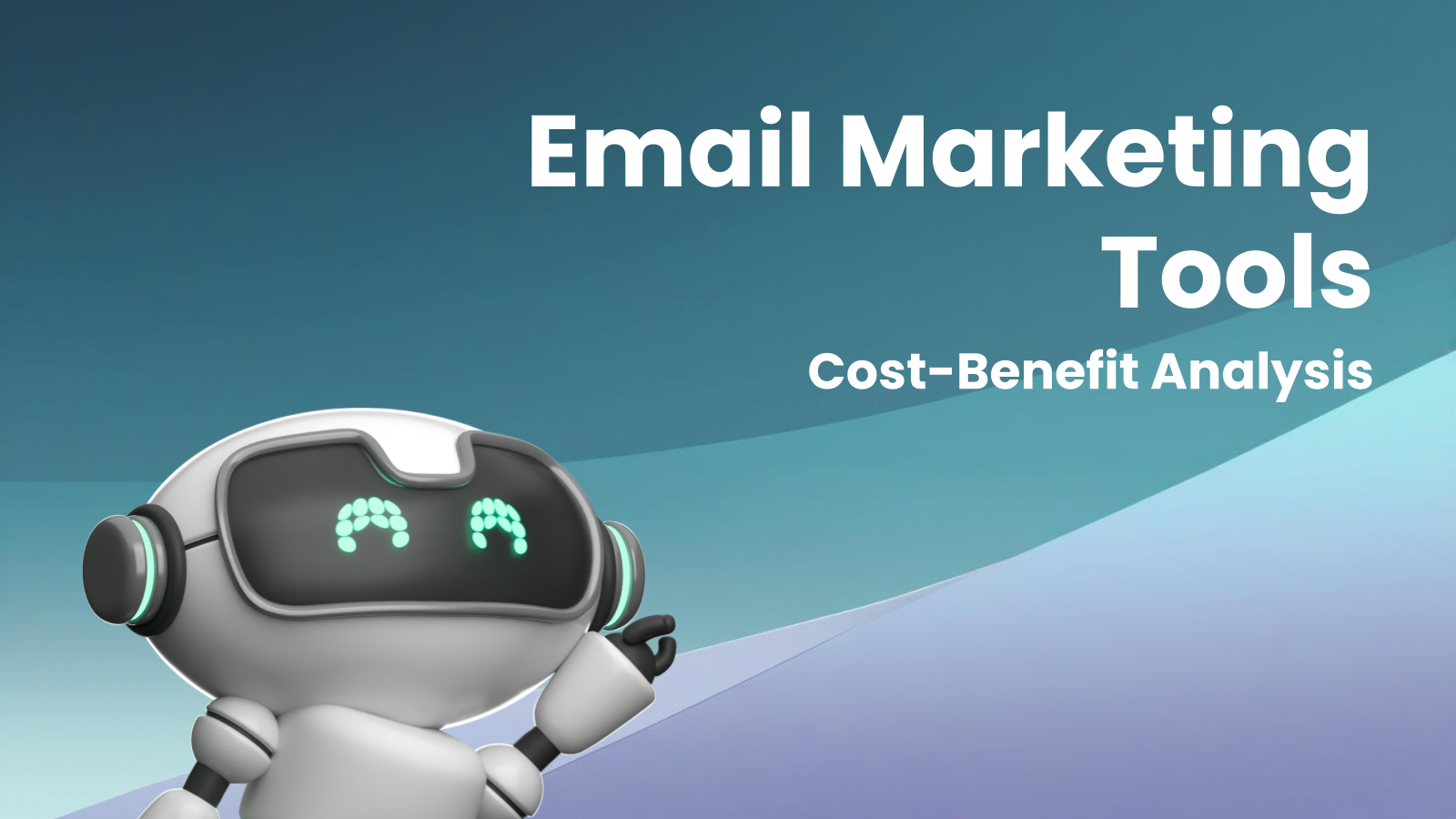Top 10 Email Marketing Tools: A Cost-Benefit Analysis

Top 10 Email Marketing Tools: A Cost-Benefit Analysis
Ever sent an email campaign and felt like you were shouting into the void? You're not alone. Many businesses struggle with email marketing, often due to choosing the wrong tool or misinterpreting its capabilities. In fact, a recent study by Litmus found that the average email open rate across all industries is only around 21.5%. That means nearly 80% of your emails might be going unopened! This article cuts through the noise and presents a detailed cost-benefit analysis of the top 10 email marketing tools, empowering you to make informed decisions and drastically improve your email marketing ROI. We'll explore features, pricing, and real-world applications to help you select the perfect platform for your specific needs.
Understanding the Power of Email Marketing Tools
Email marketing tools are software platforms that streamline the creation, sending, and tracking of email campaigns. They’ve evolved from simple broadcast systems to sophisticated platforms offering automation, segmentation, and personalized experiences. These tools matter because, despite the rise of social media, email remains a powerful and cost-effective channel for nurturing leads, driving sales, and building customer loyalty. Think of email as your direct line to your audience, allowing you to deliver targeted messages that resonate with their individual needs and interests.
The roots of modern email marketing can be traced back to the early days of the internet. However, it wasn't until the late 1990s and early 2000s that dedicated email marketing platforms began to emerge, addressing the growing need for efficient management of email lists and campaigns. These early tools focused on basic functionalities like sending mass emails and tracking open rates. Today's platforms offer a far more sophisticated array of features including marketing automation, A/B testing, and advanced analytics.
Deep Dive: Features, Pricing, and the ROI Reality
Let's dissect what these tools offer and how their price tags stack up against the potential returns.
1. Mailchimp: The industry giant, known for its user-friendly interface and extensive integrations. Its free plan is attractive for beginners, but limitations on list size and features quickly push users to paid tiers.
- Benefits: Easy to use, great for beginners, strong automation features.
- Costs: Free plan (limited), paid plans start at $13/month. Pricing increases significantly with list size.
- ROI Reality: Excellent for small businesses starting with email marketing. Example: A local bakery used Mailchimp's automation to send birthday coupons, resulting in a 15% increase in sales during customer birthday months.
2. ActiveCampaign: A powerful automation platform that excels at creating personalized customer journeys.
- Benefits: Robust automation, CRM integration, personalized email experiences.
- Costs: Plans start at $29/month.
- ROI Reality: Ideal for businesses focused on customer relationship management. Imagine a SaaS company using ActiveCampaign to onboard new users with personalized tutorials and proactive support, leading to a 20% reduction in churn.
3. HubSpot Email Marketing: Part of HubSpot's comprehensive marketing suite, offering seamless integration with its CRM.
- Benefits: Integrated CRM, marketing automation, personalized content.
- Costs: Free email marketing tools available, paid plans start at $45/month (Marketing Hub Starter).
- ROI Reality: Best for businesses already using HubSpot's CRM. A marketing agency leveraged HubSpot's integrated email and CRM to track lead interactions, resulting in a 30% increase in lead conversion rates.
4. ConvertKit: Designed specifically for creators, bloggers, and authors.
- Benefits: Easy landing page builder, powerful segmentation, focus on selling digital products.
- Costs: Plans start at $29/month.
- ROI Reality: Excellent for content creators. An online fitness coach used ConvertKit to build an email list and sell online courses, generating $10,000 in revenue within the first three months.
5. Sendinblue: Offers a robust free plan with transactional email capabilities, along with SMS marketing features.
- Benefits: Affordable, strong transactional email features, SMS marketing integration.
- Costs: Free plan available, paid plans start at $25/month.
- ROI Reality: Good for businesses needing both email and SMS marketing. An e-commerce store used Sendinblue to send order confirmations and shipping updates via SMS, improving customer satisfaction and reducing customer service inquiries.
6. Drip: Focuses on e-commerce email marketing with features like abandoned cart recovery and personalized product recommendations.
- Benefits: E-commerce focused, abandoned cart recovery, personalized product recommendations.
- Costs: Plans start at $39/month.
- ROI Reality: Best for e-commerce businesses. An online clothing retailer used Drip's abandoned cart recovery feature to recover 15% of abandoned carts, significantly boosting sales.
7. AWeber: A reliable and established platform with a strong focus on deliverability.
- Benefits: High deliverability, user-friendly interface, good customer support.
- Costs: Plans start at $19.99/month.
- ROI Reality: A good general purpose solution with reliable service. A non-profit organization uses AWeber to communicate with its donors and volunteers, ensuring its messages reach the intended audience and fostering strong relationships.
8. GetResponse: An all-in-one marketing platform with email marketing, landing pages, webinars, and automation features.
- Benefits: All-in-one marketing platform, landing page builder, webinar integration.
- Costs: Plans start at $15.58/month.
- ROI Reality: Suitable for businesses needing multiple marketing tools in one place. A business coach utilizes GetResponse's webinar feature and email marketing to promote online workshops, generating leads and driving sign-ups.
9. MailerLite: A cost-effective option with a drag-and-drop editor and good automation features.
- Benefits: Affordable, easy-to-use editor, good automation features.
- Costs: Free plan available, paid plans start at $10/month.
- ROI Reality: A good choice for small businesses on a budget. A small online store used MailerLite's drag-and-drop editor to create visually appealing email campaigns, resulting in a 10% increase in click-through rates.
10. Moosend: Known for its AI-powered features, including subject line optimization and product recommendations.
- Benefits: AI-powered features, personalized recommendations, automation.
- Costs: Free plan available, paid plans start at $9/month.
- ROI Reality: Great for businesses looking to leverage AI. An e-commerce business used Moosend's AI-powered product recommendations to increase average order value by 5%.
Common Mistakes and Challenges: A significant pitfall is failing to segment your audience. Sending generic emails to everyone is a recipe for low engagement. Also, neglecting A/B testing can prevent you from optimizing your campaigns for maximum impact. Data from Experian shows that segmented email campaigns can generate up to 14.31% higher open rates and 100.95% higher click-through rates compared to non-segmented campaigns.
Weighing the Pros and Cons: It's Not One-Size-Fits-All
Choosing the right email marketing tool involves carefully evaluating your needs and budget. While a feature-rich platform like ActiveCampaign offers powerful automation, it might be overkill for a small business just starting out. Conversely, a free plan might lack the features needed to scale your email marketing efforts.
Consider these factors:
- Business size: A solopreneur will have different needs than a large enterprise.
- Budget: Carefully assess the pricing structure and choose a plan that aligns with your financial resources.
- Technical expertise: Opt for a user-friendly platform if you lack technical skills.
- Specific features: Identify the features that are most critical to your success, such as automation, segmentation, or e-commerce integration.
Actionable Guide: Finding Your Perfect Match
- Define Your Goals: What do you want to achieve with email marketing? (e.g., generate leads, drive sales, build brand awareness)
- Identify Your Needs: What features are essential for achieving your goals?
- Research and Compare: Explore different platforms and compare their features, pricing, and user reviews.
- Take Advantage of Free Trials: Test out several platforms before committing to a paid plan.
- Start Small and Scale: Begin with a basic plan and upgrade as your needs evolve.
- Track Your Results: Monitor your key metrics (open rates, click-through rates, conversions) and adjust your strategy accordingly.
Conclusion: Email Marketing Mastery Awaits
Choosing the right email marketing tool is a critical decision that can significantly impact your business's success. By understanding the features, pricing, and ROI of different platforms, you can make an informed choice that aligns with your specific needs and goals. Remember, email marketing is an ongoing process of testing, learning, and optimization. Embrace the journey, experiment with different strategies, and continually refine your approach to unlock the full potential of this powerful channel.
Now, take a moment to reflect on your current email marketing strategy. Are you using the right tools? What steps can you take to improve your results? Consider starting a free trial with one of the tools mentioned above and see how it can transform your email marketing efforts.




